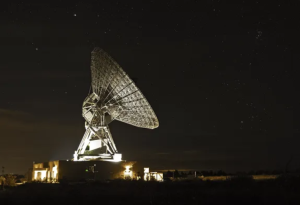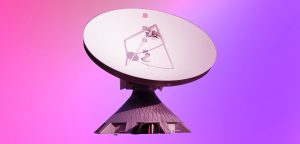GES CEO Ian Jones on the Developing Lunar Community, Deep Space, and Communications
26th Jan 2024
Goonhilly Earth Station, Ltd, (GES) calls itself ‘Your Gateway to Space’, and with good reason. Home to some of the world’s largest microwave dishes for deep space and lunar communications, GES is forging a world-wide commercial capability to support telemetry and operations for missions extending to lunar orbit and beyond. GES CEO Ian Jones is leading the development of a necessary, yet commercially high-risk, element of the future lunar economy.
Preparing for an increasingly crowded spectrum
OT: In 2022, Matt Cosby [GES CTO – ed] mentioned that when lunar oriented activity increases, there’s going to be a run for higher frequencies and data rates. Are you seeing anything like that now or are you preparing for it?
Ian Jones: S-band and X-band have been the traditional frequencies used for space exploration since the 1960s, with S-band being used for Telecommand and X-band being used for the key scientific downlink of data. These days, S-band, of course, is increasingly under threat from mobile phone operations, and it’s starting to be phased out for space communications. So new planning is all around X and Ka band for future activities where possible. But of course, the industry is always slow to move on until it has to. I think people are preparing for higher frequencies, but as it stands right now, I think pretty much most of the missions that we support are still at S and X band.
OT: Are there any directions that you would like to take that you’re hoping that the industry will move on to? Or if somebody sits down with you and asks, “hey, what should we do next?”
Ian Jones: I think that there’s going to be a push for more available bandwidth as there are more missions. So clearly, we need to move higher in frequency anyway both because of the availability of bandwidth and because higher frequency bands have higher gain for any given antenna aperture. What comes with higher frequencies, of course, apart from the need to renew equipment, is that higher frequencies require higher pointing accuracy, and particularly for deep space missions, where the pointing accuracy is one of the key parameters that differentiates deep space antennas from commercial geo antennas. It’s a matter of being prepared for that, so that we’ve got the capability on the ground ready to support the missions.
Ultimately, there’s a plan to move to optical communication. I think that will have its place, but RF communication will still be around for an awful long time.
COMSAT and global coverage
OT: Regarding GES’ COMSAT purchase, first of all, congrats on finalizing all that. Do you see any need for investments, either capital investments of some sort or some technological overhaul or optimization?
Ian Jones: COMSAT is already a Tier Four teleport under the World Teleport Association standards. And it’s fantastic to have the capability of COMSATin the Goonhilly portfolio. We are looking forward to learning a lot from the team. We came to the ground station operations business quite late in terms of the maturity of the industry. Although Goonhilly has been here for ‘forever’ in terms of the Space Age, we’re a new operator here, and we’ve built our business from the ground up, so we’re looking forward to learning a lot from the US team, who have had near continuous operations since the 1960s. However, we’re also looking forward to teaching them a lot about what we do and how we do things differently. And so while lunar and deep space communication capability is very much a part of what we want to export , we see significant growth potential in our traditional ‘near space’ business for GEO and LEO customers.
This is all part of a phased approach: We’re also in the final stages of agreeing to build some antennas in Australia as well, which will give us complete global coverage.
The important thing for us was to achieve 100% coverage of the Moon, the lunar distance. Of course, if you’re providing 100% coverage for the Moon, you’ve also got 100% coverage of the geostationary arc and most of the ecliptic arc as well. So building a set of stations that provide lunar coverage also solves a number of other problems at the same time. We had already been looking for potential locations in California to complement Australia, so when the opportunity to acquire COMSAT came along, it seemed like a natural fit. Having an East Coast location as well also fills in a gap. And then, Australia provides that final piece of the jigsaw puzzle.
So overall more capital deployment is a key part of the strategy. And yes, we’re looking to build more antennas specifically for the lunar economy and deep space. We see that there are a lot of legacy missions out in deep space that need support. We regularly support Mars Express, for example, for the European Space Agency. As you know, the lunar economy doesn’t exist yet. It’s flickering into life. And so its important to support customers to use antenna time the whole time, really
OT: Do you feel that maybe there’s a lot of attention starting to focus on lunar operations, but that people should be looking at deep space more?
Ian Jones: Deep space is a really interesting market and it’s very niche, of course, but there is an increasing need. We hear from both NASA and the European Space Agency all the time that their antennas are fully utilized, and there’s space for more antennas in the market; private antennas. But it’s still a tricky end of the market, so our approach has been to diversify our revenue streams at Goonhilly.
Okay, we bought a site that has a 32-meter antenna. In fact, we have a second 30-meter antenna here as well that is operating deep space operations, but we were only able to be successful in developing business on those difficult market-entry sectors by having other strings to our bow, with other commercial satcom business that fills in the gaps. It’s a really tricky balancing act to stand up a new service and to get sufficient revenue to cover the costs. And that’s why until now, there just hasn’t been any other commercial organization that’s managed to do what we’ve achieved. And I think it’ll remain that way for quite some time.
We’re starting to see some competition arise now because the big space agencies, NASA and ESA, have published programs that vendors can bid into, and so companies will respond to those programs. But even so, it will remain at the high end of the commercial risk. It’s also at the high end of technological risk as well. And so you have to position yourself very, very carefully to get the rewards in that market.
The developing lunar community
OT: Jenna Tiwana at ispace was talking about the excitement that was generated with the M1 mission. Do you feel that there’s maybe a community, almost like the early days of Silicon Valley, starting to coalesce around lunar operations?
Ian Jones: Yes, I think there is. I was lucky enough to be in our control room for the M1 landing. And the sense of excitement was palpable. We had our job to do. We weren’t decoding the telemetry live. We were just passing the telemetry on. We were the primary station providing the comms during the landing. And the data from Goonhilly was certainly used both live by the mission team and for their postmortem. Whilst our job was not to decode the telemetry, we could clearly see the Doppler information which directly indicated the progress of the lander so we could see that there was something amiss.
Whilst the number of mission attempts is growing, it’s still a relatively small community. We all respect each other’s capability and there’s a lot of trust developing between the different teams. That’s vitally important when your mission, and potentially your company depends on achieving good progress towards a successful lunar economy.
I guess the difference is that the teams are more globally distributed these days, so it’s not as geographically concentrated as in the early Silicon Valley days. But I think it’s certainly in the spirit of that environment where you suddenly get the leaps and bounds improvements because when you care very deeply about something, you learn very quickly from the mistakes. And I think also the mistakes and the things that go wrong, again, when you care very deeply about something, are hugely informative and really propel the improvements.
OT: One thing she mentioned was about the developing infrastructure Earthside to support the industry; not just the tech, but everything around it. For one, it’s difficult to measure risk for the satellite industry and, even more so for lunar missions. So, can you picture a way in which maybe the company would be helping either the insurance companies to quantify risk or the operators for being able to show what actually happened?
Ian Jones: It’s interesting, isn’t it? I think there certainly is a lunar economy starting to develop.There is funding fromthe U.S. government and NASA helping to spark a commercial market into existence – for US companies, of course. ESA follows suit as usual. And we’re starting to see other nations and private organizations participate like never before. Are we starting to create an economy? I think, at least for the next decade, if not two, it will continue to be significantly funded by governments before it becomes an entirely commercial operation. That funding is still going into the industry, so that’s an economy, even if it’s an artificial one, initially. And that’s important in terms of attracting investment, which I believe it does. From the UK’s point of view, I think sometimes we’re hoodwinked by the American story that this is entirely a commercial enterprise,and at least for the moment, participation is absolutely driven by government funding. There isn’t a mining industry on the Moon yet, but I’m sure, given time, a whole lunar economy will come into existence.
So then, turning to the support industries, such as insurance companies, I think it just becomes a standard risk assessment in a way that the insurance company would normally assess a risk. What are the chances of success or failure? And they will work out their premiums and their reaction to that. So we have certainly procured insurance policies for supporting our customers. For example, our antennas sit on the ground. They’re not on top of a rocket. They’re not at risk of blowing up. They’re going to be here for another 50 years. So, there’s no risk or very, very little risk to the antennas compared to a mission that’s sitting on top of a rocket and going out into space. But our customers are sitting on top of a rocket. So there’s just as much of a risk to revenue for everybody in the operational supply chain for any mission. I think there’s plenty of revenue for insurance companies to make from the entire industry. And then, of course, the more everybody works together to ensure that missions happen on time, that are successful, that they achieve their objectives, the better the position will be for the industry.
Geopolitics and the market
OT: The Russian invasion of Ukraine disrupted launch severely, especially for OneWeb. They had this tremendous mark down for the satellites that were stolen. Has the loss of access to sites in the Former Soviet Union affected the comms and ranging business at all?
Ian Jones: The loss of Russian launch sites and launch vehicles is largely mitigated by alternatives these days. Of course, it was a loss for the spacecraft that were already in Russian territory that have effectively been stolen, but this is not going to negatively affect the overall capability. The general move towards a less stable political climate is concerning and it will be necessary to take a more proactive approach to monitoring and safeguarding the world – especially from a Space perspective.
Editor’s note:
Orbital Today would like to thank Ian Jones for taking the time to speak with us! With more deep space and lunar activity planned for 2024, the year promises to be a busy one for GES.






Thank you for your comment! It will be visible on the site after moderation.